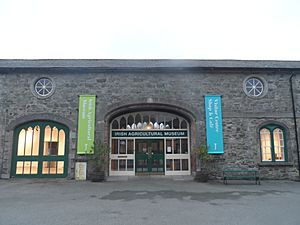Irish Agricultural Museum facts for kids
| Musaem Talmhaíochta na hÉireann | |
 |
|
 |
|
| Lua error in Module:Location_map at line 420: attempt to index field 'wikibase' (a nil value). | |
| Established | 1976 |
|---|---|
| Location | Johnstown Castle Estate, County Wexford, Ireland |
| Type | Agricultural museum |
| Visitors | 10,000 per annum |
| Public transit access | Johnstown Castle bus stop (878 bus) |
The Irish Agricultural Museum (which is Musaem Talmhaíochta na hÉireann in Irish) is a fascinating place. It teaches us all about the history of farming and country life in Ireland. You can find it in the old farm buildings and stables of Johnstown Castle in County Wexford. Inside, you'll see collections that show how people lived, traveled, made things, and farmed in the past.
How the Museum Started
In the early 1970s, a person named Dr. Austin O’Sullivan started gathering old farming tools and items from Irish country life. In 1974, Dr. Thomas Walsh, who was in charge of a group called An Foras Talúntais (now Teagasc), agreed to create a museum for these items.
A group of people came together in 1976 to set up this museum. They wanted a special place to keep Dr. O'Sullivan's collection and other similar items. The museum opened its doors in 1979. The President of Ireland at the time, Patrick Hillery, officially opened it.
Since it first opened, the museum has grown a lot. It now has a huge space of 1,900 square meters for its exhibits. As the museum expanded, the old farm buildings at Johnstown Castle, which were built in 1810, have been carefully repaired and brought back to life.
In 2011, Matt Wheeler became the museum's curator. He added exciting new exhibits, like the Harvesting Machinery Hall. He also made the museum open for longer hours, so more people could visit all year round. Since 2019, the Irish Heritage Trust has been managing the museum. In July 2022, the Heritage Council gave it full official museum status.
What You Can See Inside
The museum's main goal is to show how farming changed after the Industrial Revolution. This was a time when machines started to replace horses for farm work. The collections are organized by different farming topics. You can explore areas about dairy farming, how laundry was done, old kitchens, and even how sugar beet was grown.
There's also a big exhibit about the history of the potato. It explains the Great Famine from the mid-1800s, which was a very difficult time in Ireland. The museum even has a washing machine from the early 1950s. This washing machine is so important that it was featured as item number 96 in A History of Ireland in 100 Objects by The Irish Times.
You can also see full-size models of old workshops. These include a blacksmith's shop, where metal was shaped, and a cooper's shop, where barrels were made. There's also a wheelwright's shop for making wheels, a harness maker's shop for horse gear, and a basket maker's shop.
In 2014, the museum won the "Best Museum" award. This award was given by the Industrial Heritage Association of Ireland. It recognized the museum's great work in saving and sharing the history of Irish country life.
Gallery of Exhibits
-
A Renault R4 GTL car built in 1982 in Wexford
-
A Ferguson-Brown Model A tractor, made between 1936 and 1939





